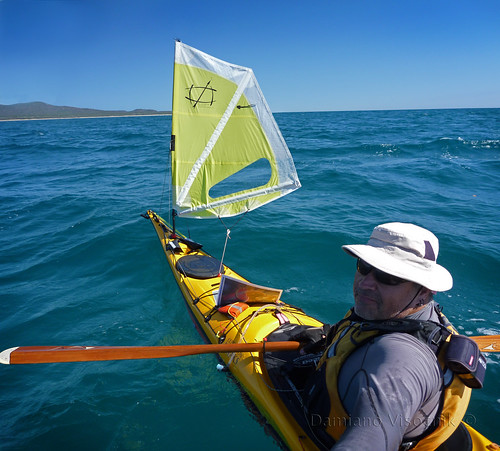The sail he sent me was a bit short for my kayak deck and the existing mounting location did not lend itself for perfect stowing on deck.
I however mounted that sail on Adventuretess' kayaks since they are shorter than mine.
She immediately liked the new sail.
I kept on using the old one that I designed (inspired by Sea Mongrel's rig).
For some reason Adveturetess seemed to always be that little bit faster than me but I assumed her boat had a better prismatic coefficient than mine...
Recently Mick sponsored me again with a new sail.
This time the sail was a bit bigger and the boom a bit longer.
I can now stow the folded sail neatly on deck (an important detail to me when I have to paddle into the wind in large seas).
After a two week trip where I was able to sail most of the time I have to report that Mick's sails rock, to put it mildly.
select 360p if you don't have fast Internet connection
His sails are superior to the old one I have used for years.
He designs a bit more twist in his high aspect sails.
Suddenly I was able to use a much wider wind "window".
I was surprised to be able to propel my kayak in winds that were just 30 degrees off the bow of my kayak.
Flat Earth Sails catch the wind better and make sailing possible where before I would stow my sail away on deck.
The shorter boom (compared to my old sail) allows full range of paddle strokes without the risk of hitting the end of the boom in a higher stroke style.

I just need to stretch myself a bit more when stowing the sail on deck while securing it with bungee and olive cleat.
As usual, Mick's work is really good.
His use of high tech/low stretch fabric for the perimeter of the sail makes the shape billow and be more efficient.
His slightly flexible boom (fibreglass sailing batten) is more forgiving in high wind gusts spilling a bit of force and preventing capsize.
I confidently sailed in beam seas where waves were washing over the deck.
I could run with the wind (wind from behind) and surf on quartering stern breezes.
On the new sail the connection of boom/mast is improved.
Mick now uses a full sleeve where the batten is inserted and then bolted to the pivoting mast fitting.
I find however that the top of the sail fabric (mast pocket) is a bit on the light side and abrasion could wear a hole prematurely. I reinforced the area with self adhesive sailing cloth (used for making numbers on sail).

old sail (left) and new one (on right)
While Mick has stock of a few different sizes of sails, he is happy to create a custom size or color for you.

Love the mast-top camera angle Gnarly, great view from up there!!! And the sails look sensational - Mick sure knows how to make 'em! Cheers - FP
ReplyDeleteHey thanks for posting this information on the sails.
ReplyDeleteI have not had a ton of experience with sails, I have plenty of downwind experience in a sea kayak. And I have sailed a bit? How much wind can the sail handle in a downwind situation, and how much can the sail take advantage of a quartering wind? Do you know how fast you are going with and without the sail in these situations?
Keith Wikle
http://www.gokayaknow.com
Keith, FEKS can handle a fair amount of wind. Ultimately it will depend on the mast and deck anchors not failing, not the sail.
ReplyDeleteI have sailed with FEKS in winds up to 25 knots but not downwind. I find that at about 15 knots the wind creates waves that can be surfed by just using the power from the sail. Any wind speed above that I guess is redundant.
Needless to say the most fun sailing is indeed downwind but you would achieve the highest speed from a quartering wind, slightly behind you.
At 20 knots things get interesting and the kayak starts to catch the little wind waves in front of you creating surge like moments.
Of all the sail I tried FEKS are the most efficient/ easy to use.
I would love to use a sail on my kayak but my one concern is how will a sail affect my roll in the event of a capsize?
ReplyDeleteIf your roll is solid and confident then it should not pose a problem and you should be fine.
ReplyDeleteI can roll with my sail in controlled environments (practice) with sail deployed (see here http://gnarlydognews.blogspot.com.au/2013/03/video-sailing-with-flat-earth-08.html ) and in anger (that means accidental capsize) by letting the uphaul out (rope that hold up the mast) so the mast is not vertical.
I find that sculling helps me to bring the kayak around as the sail in the water slows down the roll and a single powerful fast roll does not work.
Sculling is the key to all my rolling, would it be in aerated water when surfing or with a sail.